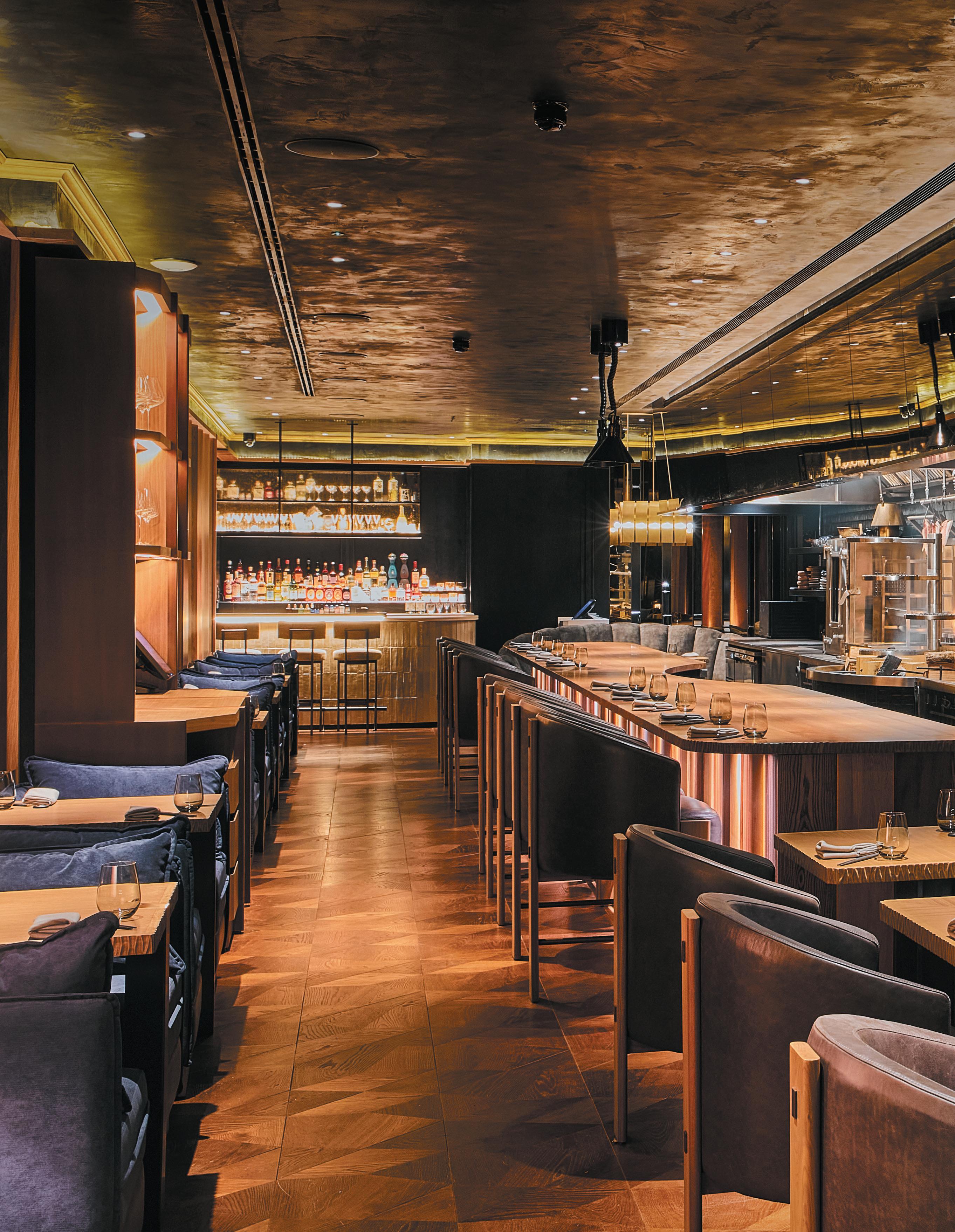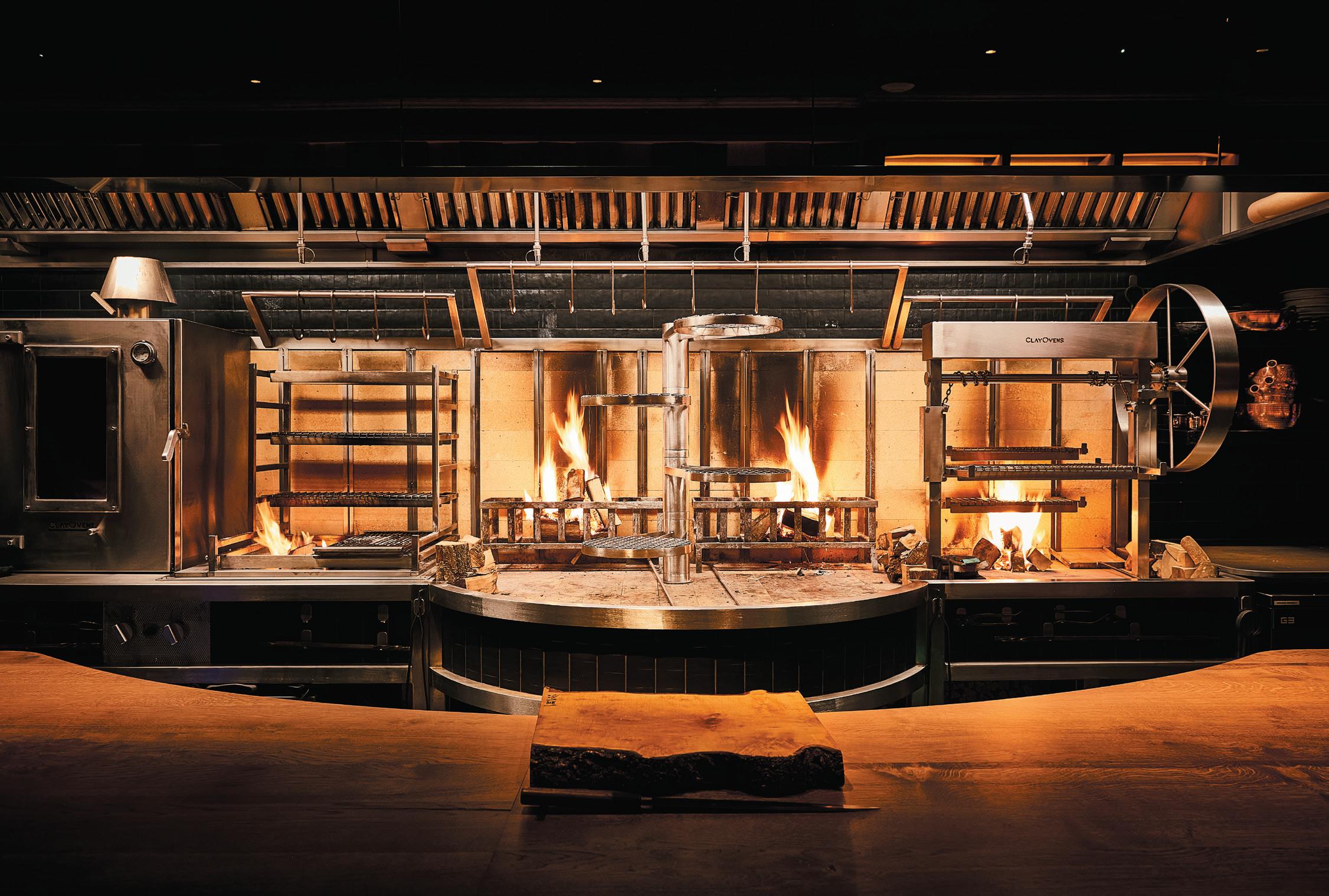
3 minute read
Dinner theatre
At the afroDItI-designed huMo, the stage is set for chef mILLer praDa’s inventive, wood-fired cuisine.
WordS: harry mckInLey

To describe a restaurant as theatrical can feel a little passé these days, such is the glut of open kitchens and at-seat dramatics – steely cloches lifted to reveal billowing dry ice or various fluids poured from great heights onto melting puddings. When paying the big bucks, we now expect, or even demand, some pizzazz; something video worthy and envy-inducing for the Instagram feed. But theatre Humo is, albeit of the slight, seductive and thankfully non-gimmicky variety.
A wood-fired dining concept in Mayfair, Humo represents the solo debut of Chef Miller Prada, a Colombian-born protégé of Endo Kazutoshi – the third-generation sushi master whose own West London restaurant holds a Michelin star. Though Miller doesn’t stick to sushi, at Humo the Japanese precision remains, even as the ingredients are more egalitarian and geographically diverse. In the preparation, no gas or oil is used – a tailor-made, four-metre-long grill both the focal point of the restaurant and the altar from which its complex dishes flow.

Wood, the central thread tying the menu together, is used both to cook and to flavour. Juniper, applewood, Aylesbury oak, birch, cherry and walnut – among a long list of others – scorch and caress, perfume and infuse, sourced from protected farms in the UK. Flames dance wildly in front of diners as great clumps of charcoal crackle, fracture and ultimately collapse into ash. Though an immersive experience, a state-of- the-art extraction system ensures guests take only their memories and a full stomach with them, not the cloying scent of burning embers.
Appreciating Miller’s esoteric culinary approach is key to understanding Humo’s interiors, with the same ideas translated into a layered, material-driven scheme. London-based studio Afroditi led the design, of course most known for its work with titans of the hospitality world, including Gordan Ramsay, Heston Blumenthal and, recently, the disruptive Experimental Group.

“We wanted to create a restaurant that reflects the unique cooking personality of Chef Miller Prada,” explains the studio’s namesake founder, Afroditi
Krassa. “But we also wanted to challenge the current stereotypical expectation of a Mayfair dining experience, with a more subtle and timeless approach.”
It’s in sidestepping that ‘stereotypical’ approach, that the studio has been able to devise something imbued with drama, yes, but also quiet finesse – with wood the similarly unifying motif.
“The concept of the whole gastronomic offer is based on using wood as a cooking ingredient, so we also used this as our creative springboard,” Krassa continues. “We created a concept based on the playful exploration of timber as the predominant material of the interior; wood on wood in all its forms and guises.”
Humo’s floor is a polished patchwork of smoked European oak, in various hues and rich with grain. One wall is clad in the different species that Prada uses in his cooking; textured and almost coaxing diners to stroke. The long timber counter, centre stage and sitting directly in front of the cooking station, was created using a felled oak from the same farm from which Prada sources some of the menu’s ingredients – the design creating a conversation between the space and the dishes.
For Krassa, that sense of connectedness was crucial. “This is a small and intimate experience; it is a destination restaurant for an audience that cares deeply about provenance, ingredients and the artistry of cooking,” she says. “It was important that every minute element of the experience is perfectly conceived and delivered; that everything is fully harmonious and coherent. Even the colour palette has been chosen to complement the live fire and its warm light, as this is the hero of the experience. So we chose darker, warm and quite muted and matt tones that work well with the fire and allow it to literarily shine.” opposIte Image: Ambient lighting creates a seductive mood
The plush dark wood stains and black rough cut stone seen throughout equally echo the fire, smoke and ash so central to Prada’s practice, creating ‘additional material layers’ that add complexity, depth and tactility. With no sense overlooked, the studio introduced a subtle fragrance, of a wet forest and moss, to carry diners away from the cacophonous streets of London and into a fertile, even primal, environment.
Beyond the front row of the counter, the main dining room is peppered with more intimate seating, mostly engineered for pairs or small groups, while downstairs, below street level, lies a ten-cover chef’s table. Here, counter seats are arranged in a crescent around an open-kitchen and flanked by temperature-controlled units holding wine and tremendous slabs of fish and meat; added stage dressing.
Krassa is correct in suggesting that Humo eschews many of the glitzier conventions of the neighbourhood and, in doing so, it weaves a compelling, fully-realised tale – one where the narrative is more important than the theatrics and substance more important than putting on a show.











